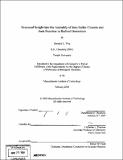Structural insight into the assembly of iron-sulfur clusters and their function in radical generation
Author(s)
Vey, Jessica L. (Jessica Lynn)
DownloadFull printable version (57.07Mb)
Other Contributors
Massachusetts Institute of Technology. Dept. of Chemistry.
Advisor
Catherine L. Drennan.
Terms of use
Metadata
Show full item recordAbstract
This thesis addresses two emerging areas in the study of iron-sulfur cluster biochemistry: bioassembly of iron-sulfur clusters, and their involvement in initiation of radical chemistry. The structure of a cysteine desulfurase involved in cluster bioassembly in the cyanobacterium Synechocystis PCC sp. 6803 was solved by X-ray crystallography and analyzed in terms of its mechanistic implications. We found that the active site cysteine responsible for the direct removal of sulfur from substrate cysteine is located on a short, well-ordered loop, consistent with structures solved of homologous proteins. The length of this loop is thought to restrain the active site cysteine, interfering with its ability to affect catalysis. Our results are consistent with the theory that this cysteine desulfurase requires an accessory protein for fully activity in vivo. Two structures of pyruvate formate-lyase activating enzyme from Escherichia coli, an Sadenosylmethionine radical enzyme, were also solved by X-ray crystallography, providing the first structure of an activase from this family of enzymes. These structures revealed the enzyme's active site and the residues involved in binding and orienting substrate for hydrogen atom abstraction. Comparison of the structures of the substrate-free and substrate-bound forms of the enzyme identified a conformational change associated with substrate binding. Detailed analyses of the structure of pyruvate formatelyase activating enzyme were carried out to provide insight into catalysis. These structures were also analyzed in comparison with other S-adenosylmethionine radical enzyme structures to more clearly understand the structural basis for reactivity in this superfamily.
Description
Thesis (Ph. D.)--Massachusetts Institute of Technology, Dept. of Chemistry, 2008. Vita. Includes bibliographical references.
Date issued
2008Department
Massachusetts Institute of Technology. Department of ChemistryPublisher
Massachusetts Institute of Technology
Keywords
Chemistry.